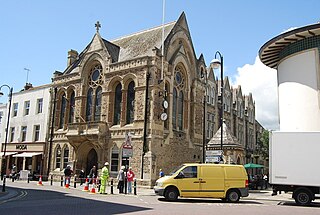
Leigh Town Hall is a municipal building in Leigh, Greater Manchester, England. It stands in Civic Square at the junction with Market Street, facing Leigh parish church. It was built in 1907 and granted grade II listed building status in 1987.

Fulham Town Hall is a municipal building on Fulham Road, Fulham, London. It is a Grade II* listed building.

Southport Town Hall is on the east side of Lord Street, Southport, Sefton, Merseyside, England. It was built in 1852–53 in Palladian style, and extended to the rear on three occasions later in the century. The town hall has a symmetrical stuccoed façade with a central staircase leading up to a porch flanked by columns. At the top of the building is a pediment with a carved tympanum. The town hall is recorded in the National Heritage List for England as a designated Grade II listed building.

Acton Town Hall is a municipal building in High Street, Acton, London, England. It is a Grade II listed building.

Bootle Town Hall is a municipal building in Oriel Road in Bootle, Merseyside, England. The building, which is the headquarters of Sefton Council, is a Grade II listed building.

Cleckheaton Town Hall is a municipal building in Bradford Road, Cleckheaton, West Yorkshire, England. The town hall, which was the headquarters of Spenborough Urban District Council, is a Grade II listed building.

Chadderton Town Hall is a municipal building on Middleton Road, Chadderton, Greater Manchester, England. The town hall, which was the headquarters of Chadderton Urban District Council, is a grade II listed building.

The Old Council House is a former municipal building in Poplar Road, Solihull, West Midlands, England. The town hall, which was the meeting place of Solihull Borough Council, is now a public house.

Hastings Town Hall is a municipal building in Queen's Road, Hastings, East Sussex, England. The town hall, which was the meeting place of Hastings Borough Council, is a Grade II listed building.

The Borough Hall is a municipal building in Eastgate Street, Stafford, Staffordshire, England. The borough hall, which formed the headquarters of Stafford Borough Council, is a Grade II listed building.

Stourbridge Town Hall is a municipal building in Market Street, Stourbridge, West Midlands, England. The town hall, which was the headquarters of Stourbridge Borough Council, is a Grade II listed building.

Slough Town Hall is a former municipal building in Bath Road, Slough, Berkshire, England. The town hall was the headquarters of Slough Borough Council until 2011. The building has been used as a school since 2012.

Oswestry Guildhall is a municipal building in Bailey Head in Oswestry, Shropshire, England. The structure, which was the meeting place of Oswestry Municipal Borough Council, is a Grade II listed building.

The Old Town Hall is a municipal building in St Andrews Street, Droitwich Spa, Worcestershire, England. The structure, which was the headquarters of Droitwich Spa Borough Council, is a Grade II listed building.

Haslemere Town Hall is a municipal building in the High Street, Haslemere, Surrey, England. The structure, which serves as the meeting place of Haslemere Town Council, is a Grade II listed building.

Horbury Town Hall is a former municipal building in Westfield Road, Horbury, West Yorkshire, England. The structure, which is now used as business centre, is a locally listed building.

Matlock Town Hall is a municipal building in Bank Road, Matlock, Derbyshire, England. The building is now used as the offices of Derbyshire Dales District Council.

Marlborough Town Hall is a municipal building in the High Street in Marlborough, Wiltshire, England. The structure, which is the meeting place of Marlborough Town Council, is a Grade II listed building.

Woking Civic Offices is a municipal building in Gloucester Walk, Woking, Surrey, England. It is in use as the headquarters of Woking Borough Council.

Bodmin Guildhall is a historic building in Fore Street in Bodmin, a town in Cornwall, in England. The structure, which was used for municipal purposes before being converted for use as a baker's shop and restaurant, is a Grade II listed building.





















